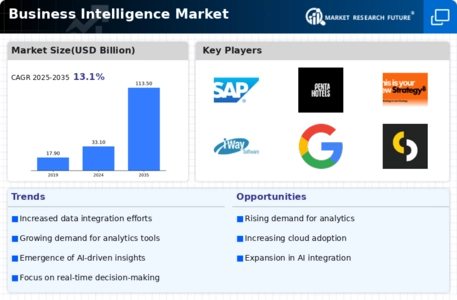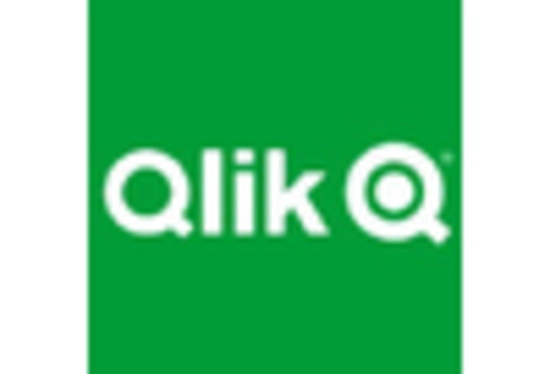-
MARKET INTRODUCTION
-
INTRODUCTION
-
SCOPE OF STUDY
- RESEARCH OBJECTIVE
- ASSUMPTIONS
- LIMITATIONS
-
MARKET STRUCTURE
-
RESEARCH METHODOLOGY
-
RESEARCH NETWORK SOLUTION
-
PRIMARY RESEARCH
-
SECONDARY RESEARCH
-
FORECAST MODEL
- MARKET DATA COLLECTION, ANALYSIS & FORECAST
- MARKET SIZE ESTIMATION
-
MARKET DYNAMICS
-
INTRODUCTION
-
MARKET DRIVERS
-
MARKET CHALLENGES
-
MARKET OPPORTUNITIES
-
MARKET RESTRAINTS
-
EXECUTIVE SUMMARY
-
MARKET FACTOR ANALYSIS
-
PORTER’S FIVE FORCES ANALYSIS
-
SUPPLY CHAIN ANALYSIS
-
GLOBAL BUSIBESS INTELLIGENCE MARKET, BY SEGMENTS
-
INTRODUCTION
-
MARKET STATISTICS
- BY TECHNOLOGY
- BY SERVICE
- BY DEPLOYMNET
- BY COMPONENT
- BY ORGANISATION
- BY INDUSTRY
-
COMPETITIVE ANALYSIS
-
MARKET SHARE ANALYSIS
-
COMPANY PROFILES
- VERIZON WIRELESS (U.S.)
- RACKSPACE (U.S.
- AT&T (U.S)
- CISCO SYSTEMS (U.S.)
- IBM CORP. (U.S.)
- JUNIPER NETWORKS (U.S.)
- MICROSOFT CORP. (U.S)
- VMWARE (U.S.)
- SAS INSTITUTE INC. (U.S.)
- SAP SE (GERMANY)
- OTHERS
-
LIST OF TABLES
-
GLOBAL BUSINESS INTELLIGENCE MARKET, TECHNOLOGY
-
GLOBAL BUSINESS INTELLIGENCE MARKET, BY SERVICE
-
GLOBAL BUSINESS INTELLIGENCE MARKET, BY DEPLOYMENT
-
GLOBAL BUSINESS INTELLIGENCE MARKET, BY COMPONENT
-
GLOBAL BUSINESS INTELLIGENCE MARKET, BY ORGANIZATION
-
GLOBAL BUSINESS INTELLIGENCE MARKET, BY INDUSTRY
-
NORTH AMERICA BUSINESS INTELLIGENCE MARKET, BY TECHNOLOGY
-
NORTH AMERICA BUSINESS INTELLIGENCE MARKET, BY SERVICE
-
NORTH AMERICA BUSINESS INTELLIGENCE MARKET, BY DEPLOYMENT
-
NORTH AMERICA BUSINESS INTELLIGENCE MARKET, BY COMPONENT
-
NORTH AMERICA BUSINESS INTELLIGENCE MARKET, BY ORGANIZATION
-
NORTH AMERICA BUSINESS INTELLIGENCE MARKET, BY INDUSTRY
-
U.S. BUSINESS INTELLIGENCE, BY TECHNOLOGY
-
U.S. BUSINESS INTELLIGENCE MARKET, BY SERVICE
-
U.S. BUSINESS INTELLIGENCE MARKET, BY DEPLOYMENT
-
U.S. BUSINESS INTELLIGENCE MARKET, BY COMPONENT
-
U.S. BUSINESS INTELLIGENCE MARKET, BY ORGANIZATION
-
U.S. BUSINESS INTELLIGENCE MARKET, BY INDUSTRY
-
CANADA BUSINESS INTELLIGENCE MARKET, BY TECHNOLOGY
-
CANADA BUSINESS INTELLIGENCE MARKET, BY SERVICE
-
CANADA BUSINESS INTELLIGENCE MARKET, BY DEPLOYMENT
-
CANADA BUSINESS INTELLIGENCE MARKET, BY COMPONENT
-
CANADA BUSINESS INTELLIGENCE MARKET, BY ORGANIZATION
-
CANADA BUSINESS INTELLIGENCE MARKET, BY INDUSTRY
-
EUROPE BUSINESS INTELLIGENCE MARKET, BY TECHNOLOGY
-
EUROPE BUSINESS INTELLIGENCE MARKET, BY SERVICE
-
EUROPE BUSINESS INTELLIGENCE MARKET, BY DEPLOYMENT
-
EUROPE BUSINESS INTELLIGENCE MARKET, BY COMPONENT
-
EUROPE BUSINESS INTELLIGENCE MARKET, BY ORGANIZATION
-
EUROPE BUSINESS INTELLIGENCE MARKET, BY INDUSTRY
-
GERMANY BUSINESS INTELLIGENCE MARKET, TECHNOLOGY
-
GERMANY BUSINESS INTELLIGENCE MARKET, BY SERVICE
-
GERMANY BUSINESS INTELLIGENCE MARKET, BY DEPLOYMNET
-
GERMANY BUSINESS INTELLIGENCE MARKET, BY COMPONENT
-
GERMANY BUSINESS INTELLIGENCE MARKET, BY ORGANIZATION
-
GERMANY BUSINESS INTELLIGENCE MARKET, BY INDUSTRY
-
FRANCE BUSINESS INTELLIGENCE MARKET, BY TECHNOLOGY
-
FRANCE BUSINESS INTELLIGENCE MARKET, BY SERVICE
-
FRANCE BUSINESS INTELLIGENCE MARKET, BY DEPLOYMENT
-
0 FRANCE BUSINESS INTELLIGENCE MARKET, BY COMPONENT
-
FRANCE BUSINESS INTELLIGENCE MARKET, BY ORGANIZATION
-
FRANCE BUSINESS INTELLIGENCE MARKET, BY INDUSTRY
-
U.K. BUSINESS INTELLIGENCE MARKET, BY TECHNOLOGY
-
U.K. BUSINESS INTELLIGENCE MARKET, BY SERVICE
-
U.K. BUSINESS INTELLIGENCE MARKET, BY DEPLOYMENT
-
U.K. BUSINESS INTELLIGENCE MARKET, BY COMPONENT
-
U.K. BUSINESS INTELLIGENCE MARKET, BY ORGANIZATION
-
U.K. BUSINESS INTELLIGENCE MARKET, BY INDUSTRY
-
REST OF EUROPE BUSINESS INTELLIGENCE MARKET, BY TECHNOLOGY
-
REST OF EUROPE BUSINESS INTELLIGENCE MARKET, BY SERVICE
-
REST OF EUROPE BUSINESS INTELLIGENCE MARKET, BY DEPLOYMENT
-
REST OF EUROPE BUSINESS INTELLIGENCE MARKET, BY COMPONENT
-
REST OF EUROPE BUSINESS INTELLIGENCE MARKET, BY ORGANIZATION
-
REST OF EUROPE BUSINESS INTELLIGENCE MARKET, BY INDUSTRY
-
ASIA-PACIFIC BUSINESS INTELLIGENCE MARKET, BY TECHNOLOGY
-
ASIA-PACIFIC BUSINESS INTELLIGENCE MARKET, BY SERVICE
-
ASIA-PACIFIC BUSINESS INTELLIGENCE MARKET, BY DEPLOYMENT
-
ASIA-PACIFIC BUSINESS INTELLIGENCE MARKET, BY COMPONENT
-
ASIA-PACIFIC BUSINESS INTELLIGENCE MARKET, ORGANIZATION
-
ASIA-PACIFIC BUSINESS INTELLIGENCE MARKET, INDUSTRY
-
MIDDLE EAST & AFRICA BUSINESS INTELLIGENCE MARKET, BY TECHNOLOGY
-
MIDDLE EAST & AFRICA BUSINESS INTELLIGENCE MARKET, BY SERVICE
-
MIDDLE EAST & AFRICA BUSINESS INTELLIGENCE MARKET, BY DEPLOYMENT
-
MIDDLE EAST & AFRICA BUSINESS INTELLIGENCE MARKET, BY COMPONENT
-
MIDDLE EAST & AFRICA BUSINESS INTELLIGENCE MARKET, BY ORGANIZATION
-
MIDDLE EAST & AFRICA BUSINESS INTELLIGENCE MARKET, BY INDUSTRY
-
LIST OF FIGURES
-
RESEARCH NETWORK SOLUTION (%)
-
GLOBAL BUSINESS INTELLIGENCE MARKET: BY TECHNOLOGY (%)
-
GLOBAL BUSINESS INTELLIGENCE MARKET: BY SERVICE (%)
-
GLOBAL BUSINESS INTELLIGENCE MARKET: BY DEPLOYMENT (%)
-
GLOBAL BUSINESS INTELLIGENCE MARKET: BY COMPONENT (%)
-
GLOBAL BUSINESS INTELLIGENCE MARKET: BY ORGANIZATION
-
GLOBAL BUSINESS INTELLIGENCE MARKET: BY INDUSTRY
-
NORTH AMERICA BUSINESS INTELLIGENCE MARKET, BY TECHNOLOGY (%)
-
NORTH AMERICA BUSINESS INTELLIGENCE MARKET, BY SERVICE (%)
-
NORTH AMERICA BUSINESS INTELLIGENCE MARKET, BY DEPLOYMENT (%)
-
NORTH AMERICA BUSINESS INTELLIGENCE MARKET, BY COMPONENT (%)
-
NORTH AMERICA BUSINESS INTELLIGENCE MARKET, BY ORGANIZATION (%)
-
NORTH AMERICA BUSINESS INTELLIGENCE MARKET, BY INDUSTRY (%)
-
EUROPE BUSINESS INTELLIGENCE MARKET, BY TECHNOLOGY (%)
-
EUROPE BUSINESS INTELLIGENCE MARKET, BY SERVICE (%)
-
EUROPE BUSINESS INTELLIGENCE MARKET, BY DEPLOYMENT (%)
-
EUROPE BUSINESS INTELLIGENCE MARKET, BY COMPONENT (%)
-
EUROPE BUSINESS INTELLIGENCE MARKET, BY ORGANIZATION (%)
-
EUROPE BUSINESS INTELLIGENCE MARKET, BY INDUSTRY (%)
-
ASIA-PACIFIC BUSINESS INTELLIGENCE MARKET, BY TECHNOLOGY (%)
-
ASIA-PACIFIC BUSINESS INTELLIGENCE MARKET, BY SERVICE (%)
-
ASIA-PACIFIC BUSINESS INTELLIGENCE MARKET, BY DEPLOYMENT (%)
-
ASIA-PACIFIC BUSINESS INTELLIGENCE MARKET, BY COMPONENT (%)
-
ASIA-PACIFIC BUSINESS INTELLIGENCE MARKET, BY ORGANIZATION (%)
-
ASIA-PACIFIC BUSINESS INTELLIGENCE MARKET, BY INDUSTRY (%)
-
ROW BUSINESS INTELLIGENCE MARKET, BY TECHNOLOGY (%)
-
ROW BUSINESS INTELLIGENCE MARKET, BY SERVICE (%)
-
ROW BUSINESS INTELLIGENCE MARKET, BY DEPLOYMENT (%)
-
ROW BUSINESS INTELLIGENCE MARKET, BY COMPONENT (%)
-
ROW BUSINESS INTELLIGENCE MARKET, BY ORGANIZATION (%)
-
ROW BUSINESS INTELLIGENCE MARKET, BY INDUSTRY (%)









Leave a Comment